|
|
|
 |
|
|
|
|
|
|
|
Station Road
|
|
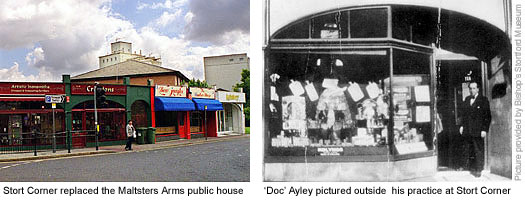 |
|
|
|
The north-east side of Station Road at its junction with South Street is called Stort Corner – the name given to the short terrace of single-storey shops built in 1926 to replace the Maltsters Arms public house (See Guide 15). In the 1930s one of these shops was the Stort Corner Pharmacy, owned by Cecil 'Doc' Ayley. A local chemist and dental practitioner, he apparently exhorted his patients back to good health by removing their teeth. He is probably less remembered for helping found the local Conservative Club.
Station Road continues to the junction with London Road, via the railway bridge, beyond which is a former malting occupied from 1921–2002 by mechanical and electrical engineering firm, Fyfe Wilson & Co. Before they established themselves here, ownership of the firm was decided on the toss of a coin between its then joint owners, Mr Tucker and Mr Herbert Dearlove. Whether Mr Dearlove called heads or tails isn’t known, but he won the toss and the engineering works have remained in his family ever since. Once totally dependent on local manufacturing, the change to mainly service industries forced the firm change their ways and they now trade worldwide from new headquarters at Raynham Road. Future redevelopment of their old site for housing means it's unlikely that any part of the former malting will remain.
On the opposite side of the road the large and rather nondescript building once housed Bishop's Stortford's 'new' telephone exchange. Up until the late 1950s telephone subscribers in any town or city could make local calls by dialing direct, but if the distance was greater than 15 miles the call became a trunk call i.e. long distance, and had to be connected by an operator.
This all changed in 1958 when Subscriber Trunk Dialing (STD) was introduced to the UK: a fully automated system that allowed subscribers (quaintly termed 'customers' in 1959) to dial direct any distance – although initially that distance was only about 300 miles. STD technology was finally introduced to Stortford in November 1963 when the town's old telephone exchange at Nails Lane, behind the former South Street post office, was replaced by this exchange. Further changes to the telephone system in the 1980s resulted in centralisation of services at Cambridge and closure of this exchange. The building now serves as a British Telecom depot.
|
|
|
|
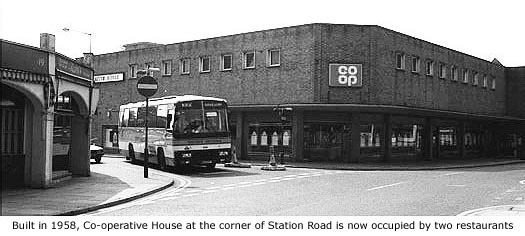 |
|
|
|
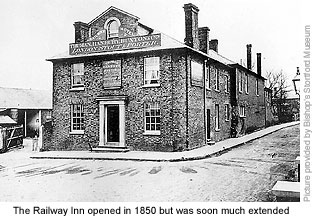 After the railway arrived in Bishop’s Stortford in 1842, it was only a matter of time before an inn would be built close by and assume the name ‘Railway Inn’. Thomas Heskin Court, the large Victorian building at the junction of Station Road and London Road, was that inn. Opened in 1850 it was owned in 1852 by James Patmore, an industrious man who earned his living as an ale and porter merchant and also as a hearse and mourning coach maker. After the railway arrived in Bishop’s Stortford in 1842, it was only a matter of time before an inn would be built close by and assume the name ‘Railway Inn’. Thomas Heskin Court, the large Victorian building at the junction of Station Road and London Road, was that inn. Opened in 1850 it was owned in 1852 by James Patmore, an industrious man who earned his living as an ale and porter merchant and also as a hearse and mourning coach maker.
In the following decade the Railway Inn became a regular host to the local volunteer movement: part of an Association initially set up during the Napoleonic Wars (1793–1815) when England was threatened with invasion by the French. The movement continued to flourish well into the 19th century, and in 1862 a local man named John Dobede Fairman created Bishop’s Stortford’s very own ‘regiment’, the 1st Herts Light Horse Volunteers (See Guide 5 - Silver Leys). Queen Victoria accepted the troops services in November 1862 and Fairman, commissioned as captain, took the very first parade at the Railway Inn on 27 December that same year.
|
|
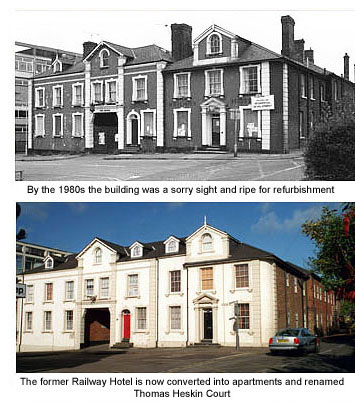 Later renamed The Railway Hotel the building is now substantially larger than the original inn, its stable courtyard having had extensive additions built around it in the late 19th century to increase the number of rooms available for travellers. Later renamed The Railway Hotel the building is now substantially larger than the original inn, its stable courtyard having had extensive additions built around it in the late 19th century to increase the number of rooms available for travellers.
In the first half of the 20th century the hotel also became a popular venue for dances, wedding parties and receptions – a notable occasion being the reception held in 1935 to celebrate the opening of the Regent cinema in South Street (See Guide 15). But in the late 1960s the hotel took on an entirely different role.
Two town-based music clubs notable for the promotion of Blues music during the late 1950s and early 60s had been the Mitre Club (See Guide 14) and the Bluesday Club (See Guide 13). They closed when tastes in 'popular' music changed, but fans of Blues music still wanted to be entertained and when the opportunity to open a new venue devoted entirely to Blues music arose, a young promoter named Steve Miller (1943–1998) seized the opportunity.
|
|
 A professional pianist, he had briefly run a small club in Hoddesdon, Hertfordshire, but joined with the Railway Hotel’s landlord, Gary Lane, to open Rambling Jack’s Blues Club on 10 January 1968. Every Wednesday evening, for almost two years, both new and established bands would play here, the most noteworthy names being Dr K’s Blues Band (playing on the opening night), Jack Dupree, Chicken Shack, Jethro Tull, Free, and Alexis Korner (1929–1984) – arguably once the most well known patron of Blues music in this country. A professional pianist, he had briefly run a small club in Hoddesdon, Hertfordshire, but joined with the Railway Hotel’s landlord, Gary Lane, to open Rambling Jack’s Blues Club on 10 January 1968. Every Wednesday evening, for almost two years, both new and established bands would play here, the most noteworthy names being Dr K’s Blues Band (playing on the opening night), Jack Dupree, Chicken Shack, Jethro Tull, Free, and Alexis Korner (1929–1984) – arguably once the most well known patron of Blues music in this country.
|
|
It was Alexis Korner who had encouraged the Rolling Stones in their early days and also helped countless other musicians on the road to success. His popularity was such that in August 1968, on the third of his five appearances here, he played to an audience of 300 people. It was the pinnacle of the club’s success story.
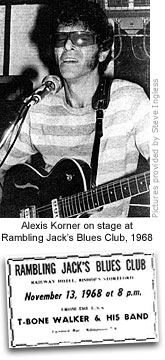 The club was eventually forced to close its doors to the public when booking agencies began demanding more and more money for their artists to appear – far in excess of what the club’s finances could offer. The final event on 19 November 1969 featured Steve Miller’s own band, Delivery, who played to an audience of 160 people. The club was eventually forced to close its doors to the public when booking agencies began demanding more and more money for their artists to appear – far in excess of what the club’s finances could offer. The final event on 19 November 1969 featured Steve Miller’s own band, Delivery, who played to an audience of 160 people.
In 1976 another music club took up residence at the Railway Hotel, established by a group of young people whose sole desire was to keep alive the rock ‘n’ roll sound of the 1950s. Aptly named Houndogs, the club began by playing rock ‘n’ roll records to a paying audience, the weekly event becoming so successful that very soon ‘new’ rock ‘n’ roll bands from around the country were being booked to play. At one point membership was close to 400, with people travelling from as far as Norwich and Southend to attend the weekly meetings.
Sadly, for the club, the Railway Hotel was eventually sold for redevelopment in 1984, and in 1988 Houndogs moved on; first to the Half Moon at North Street and then to the Cellarman at Havers Lane. Attendances dwindled for a short while and events were shelved, but Houndogs was eventually given a new lease of life by long-term members Jim Thompson and his wife Louise, and fellow Stortford residents Ian Austin and Zena Osbourne. They secured Newport Village Hall in Essex as a permanent venue. With a current membership of almost 500, Houndogs is as popular now as it was when it started in 1976 and is, arguably, the oldest rock ‘n’ roll club in the country. www.houndogs.co.uk
Live music in the town hasn’t disappeared entirely. The new venue for music lovers is the Half Moon public house in North Street, where visiting Blues bands perform and local musicians regularly hold jam sessions (See Guide 6).
•All references regarding music at the Railway Hotel was taken from 'The Day Before Yesterday' by Steve Ingless
|
|
|
|
[ BACK TO TOP ] |
|
|
|
|
|
|
|




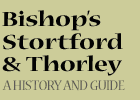
 After the railway arrived in Bishop’s Stortford in 1842, it was only a matter of time before an inn would be built close by and assume the name ‘Railway Inn’. Thomas Heskin Court, the large Victorian building at the junction of Station Road and London Road, was that inn. Opened in 1850 it was owned in 1852 by James Patmore, an industrious man who earned his living as an ale and porter merchant and also as a hearse and mourning coach maker.
After the railway arrived in Bishop’s Stortford in 1842, it was only a matter of time before an inn would be built close by and assume the name ‘Railway Inn’. Thomas Heskin Court, the large Victorian building at the junction of Station Road and London Road, was that inn. Opened in 1850 it was owned in 1852 by James Patmore, an industrious man who earned his living as an ale and porter merchant and also as a hearse and mourning coach maker. Later renamed The Railway Hotel the building is now substantially larger than the original inn, its stable courtyard having had extensive additions built around it in the late 19th century to increase the number of rooms available for travellers.
Later renamed The Railway Hotel the building is now substantially larger than the original inn, its stable courtyard having had extensive additions built around it in the late 19th century to increase the number of rooms available for travellers. A professional pianist, he had briefly run a small club in Hoddesdon, Hertfordshire, but joined with the Railway Hotel’s landlord, Gary Lane, to open Rambling Jack’s Blues Club on 10 January 1968. Every Wednesday evening, for almost two years, both new and established bands would play here, the most noteworthy names being Dr K’s Blues Band (playing on the opening night), Jack Dupree, Chicken Shack, Jethro Tull, Free, and Alexis Korner (1929–1984) – arguably once the most well known patron of Blues music in this country.
A professional pianist, he had briefly run a small club in Hoddesdon, Hertfordshire, but joined with the Railway Hotel’s landlord, Gary Lane, to open Rambling Jack’s Blues Club on 10 January 1968. Every Wednesday evening, for almost two years, both new and established bands would play here, the most noteworthy names being Dr K’s Blues Band (playing on the opening night), Jack Dupree, Chicken Shack, Jethro Tull, Free, and Alexis Korner (1929–1984) – arguably once the most well known patron of Blues music in this country. The club was eventually forced to close its doors to the public when booking agencies began demanding more and more money for their artists to appear – far in excess of what the club’s finances could offer. The final event on 19 November 1969 featured Steve Miller’s own band, Delivery, who played to an audience of 160 people.
The club was eventually forced to close its doors to the public when booking agencies began demanding more and more money for their artists to appear – far in excess of what the club’s finances could offer. The final event on 19 November 1969 featured Steve Miller’s own band, Delivery, who played to an audience of 160 people.